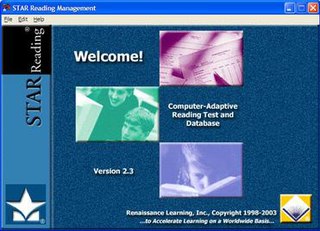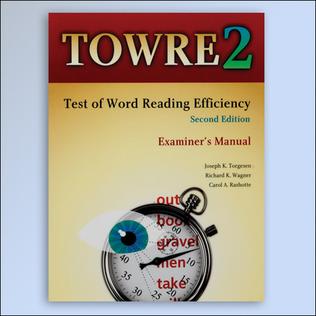Related Research Articles

A standardized test is a test that is administered and scored in a consistent, or "standard", manner. Standardized tests are designed in such a way that the questions and interpretations are consistent and are administered and scored in a predetermined, standard manner.
The Stanford–Binet Intelligence Scales is an individually administered intelligence test that was revised from the original Binet–Simon Scale by Alfred Binet and Théodore Simon. It is now in its fifth edition (SB5), which was released in 2003.
Educational assessment or educational evaluation is the systematic process of documenting and using empirical data on the knowledge, skill, attitudes, aptitude and beliefs to refine programs and improve student learning. Assessment data can be obtained from directly examining student work to assess the achievement of learning outcomes or can be based on data from which one can make inferences about learning. Assessment is often used interchangeably with test, but not limited to tests. Assessment can focus on the individual learner, the learning community, a course, an academic program, the institution, or the educational system as a whole. The word 'assessment' came into use in an educational context after the Second World War.
Cognitive tests are assessments of the cognitive capabilities of humans and other animals. Tests administered to humans include various forms of IQ tests; those administered to animals include the mirror test and the T maze test. Such testing is used in psychology and psychometrics, as well as other fields studying human and animal intelligence.
The Education Quality and Accountability Office (EQAO) is a Crown agency of the Government of Ontario in Canada. It was legislated into creation in 1996 in response to recommendations made by the Royal Commission on Learning in February 1995.
The Wechsler Intelligence Scale for Children (WISC) is an individually administered intelligence test for children between the ages of 6 and 16. The Fifth Edition is the most recent version.
Alan S. Kaufman is an American psychologist and writer known for his work on intelligence testing.

The IEA's Progress in International Reading Literacy Study (PIRLS) is an international study of reading (comprehension) achievement in 9-10 year olds. It has been conducted every five years since 2001 by the International Association for the Evaluation of Educational Achievement (IEA). It is designed to measure children's reading literacy achievement, to provide a baseline for future studies of trends in achievement, and to gather information about children's home and school experiences in learning to read.

STAR Reading, STAR Early Literacy and STAR Math are standardized, computer-adaptive assessments created by Renaissance Learning, Inc., for use in K–12 education. Each is a "Tier 2" assessment of a skill that can be used any number of times due to item-bank technology. These assessments fall somewhere between progress monitoring tools and high-stakes tests.
The Kaufman Assessment Battery for Children (KABC) is a clinical instrument for assessing cognitive development. Its construction incorporates several recent developments in both psychological theory and statistical methodology. The test was developed by Alan S. Kaufman and Nadeen L. Kaufman in 1983 and revised in 2004. The test has been translated and adopted for many countries, such as the Japanese version of the K-ABC by the Japanese psychologists Tatsuya Matsubara, Kazuhiro Fujita, Hisao Maekawa, and Toshinori Ishikuma.
Western Aphasia Battery (WAB) is an instrument for assessing the language function of adults with suspected neurological disorders as a result of a stroke, head injury, or dementia. There is an updated version, the Western Aphasia Battery-Revised (WAB-R). It helps discern the presence, degree, and type of aphasia. It also measures how the patient performed on the test to provide a baseline so they can detect changes throughout their time in therapy. This also allows to see the patient's language strengths and weaknesses so that they can figure out what to treat, and lastly, it can infer the location of the lesion that caused aphasia. Another such test is the Boston Diagnostic Aphasia Examination. The WAB targets English speaking adults and teens with a neurological disorder between the ages of 18 and 89 years old. The WAB tests both linguistic and non linguistic skills. The linguistic skills assessed include, speech, fluency, auditory comprehension, reading and writing. The non-linguistic skills tested include drawing, calculation, block design and apraxia.
The Boston Diagnostic Aphasia Examination is a neuropsychological battery used to evaluate adults suspected of having aphasia, and is currently in its third edition. It was created by Harold Goodglass and Edith Kaplan. The exam evaluates language skills based on perceptual modalities, processing functions, and response modalities. Administration time ranges from 20 to 45 minutes for the shortened version but it can last up to 120 minutes for the extended version of the assessment. There are five subtests which include: conversational & expository speech, auditory comprehension, oral expression, reading, and writing. In the extended version all questions are asked while in the shortened version only a few questions are asked within each subtest. Many other tests are sometimes used by neurologists and speech language pathologists on a case-by-case basis, and other comprehensive tests exist like the Western Aphasia Battery.

Learning disability, learning disorder, or learning difficulty is a condition in the brain that causes difficulties comprehending or processing information and can be caused by several different factors. Given the "difficulty learning in a typical manner", this does not exclude the ability to learn in a different manner. Therefore, some people can be more accurately described as having a "learning difference", thus avoiding any misconception of being disabled with a lack of ability to learn and possible negative stereotyping. In the United Kingdom, the term "learning disability" generally refers to an intellectual disability, while conditions such as dyslexia and dyspraxia are usually referred to as "learning difficulties".
The Wechsler Individual Achievement Test Second Edition assesses the academic achievement of children, adolescents, college students and adults, aged 4 through 85. The test enables the assessment of a broad range of academics skills or only a particular area of need. The WIAT-II is a revision of the original WIAT, and additional measures. There are four basic scales: Reading, Math, Writing and Oral Language. Within these scales there is a total of 9 sub-test scores.
The Lexile Framework for Reading is an educational tool that uses a measure called a Lexile to match readers with books, articles and other leveled reading resources. Readers and books are assigned a score on the Lexile scale, in which lower scores reflect easier readability for books and lower reading ability for readers. The Lexile framework uses quantitative methods, based on individual words and sentence lengths, rather than qualitative analysis of content to produce scores. Accordingly, the scores for texts do not reflect factors such as multiple levels of meaning or maturity of themes. Hence, the United States Common Core State Standards recommend the use of alternative, qualitative methods for selecting books for students at grade 6 and over. In the US, Lexile measures are reported from reading programs and assessments annually. Thus, about half of U.S. students in grades 3rd through 12th receive a Lexile measure each year. In addition to being used in schools in all 50 states, Lexile measures are also used outside of the United States.
The Woodcock–Johnson Tests of Cognitive Abilities is a set of intelligence tests first developed in 1977 by Richard Woodcock and Mary E. Bonner Johnson. It was revised in 1989, again in 2001, and most recently in 2014; this last version is commonly referred to as the WJ IV. They may be administered to children from age two right up to the oldest adults. The previous edition WJ III was praised for covering "a wide variety of cognitive skills".
The Peabody Individual Achievement Test is a criterion based survey of an individual’s scholastic attainment. It can be administered to individuals between the ages of five and 22 years of age, and returns a grade range between Kindergarten and grade 12. The test is available in English and Spanish.

Test of Word Reading Efficiency Second Edition or commonly known as TOWRE - 2 is a kind of reading test developed to test the efficiency of reading ability of children from age 6–24 years. It generally seeks to measure an individual's accuracy and fluency regarding two efficiencies; Sight Word Efficiency (SWE) and Phonemic Decoding Efficiency (PDE). SWE measures ability of pronouncing words that are printed and PDE assesses the quantity of pronouncing phonemically regular non-words. TOWRE - 2 is a very simple test which can be administered by teachers and aides, and it only takes five minutes to complete the procedure. It is commonly used in reading research, classroom assessment and clinical practice. This test is both straightforward and easy to use because it does not require a lot of materials and can be administered by teachers and aides.
The Wide Range Intelligence test (WRIT) is an assessment of verbal (crystallized) and visual (fluid) IQ. Running at approximately 30 minutes, the WRIT is shorter than traditional IQ tests. The test also involves only four subtests and requires fewer physical materials than a typical test. It was created alongside the Wide Range Achievement Test 3 (WRAT3), a measure of reading comprehension and academic ability, by Pearson Education in 2000. The WRIT is intended to assess those aged 4 through 85. It is designed for easy administration among trained psychologists, which is accomplished using a hierarchical model that frequently occurs in psychological testing.
References
- 1 2 Wilkinson, G. S., & Robertson, G. J. (2017). Wide Range Achievement Test professional manual (5th edition). Bloomington, MN: NCS Pearson, Inc.
- ↑ Reynolds, Cecil R.; and Fletcher-Janzen, Elaine. "Encyclopedia of special education", p. 248. John Wiley & Sons, 2007. ISBN 0-471-67802-3. Accessed July 23, 2009.